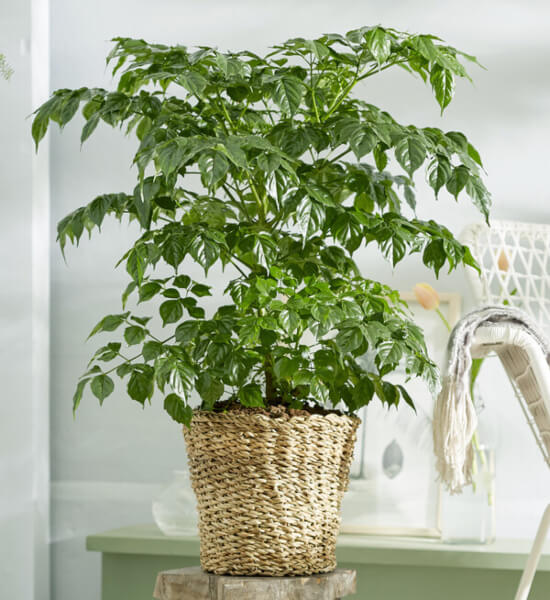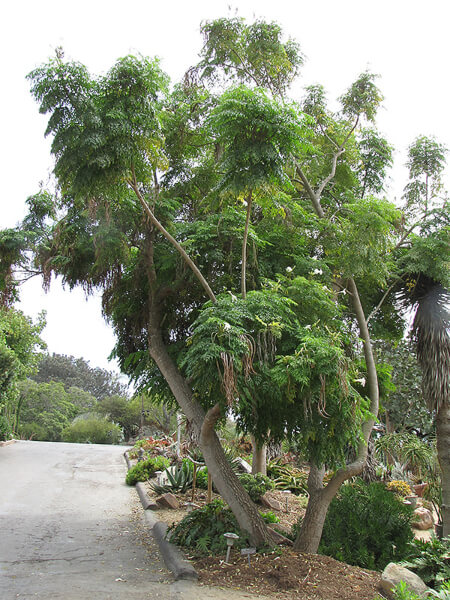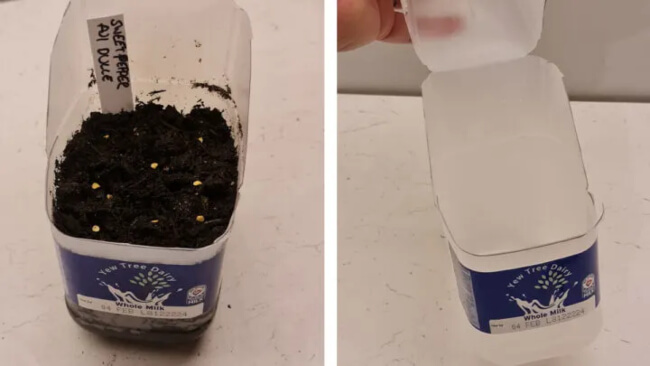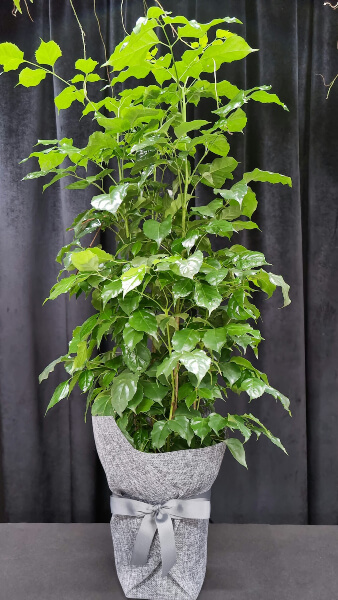Outdoors, China doll plants (Radermachera sinica) are beautiful flowering additions to any garden and will grow into a gorgeously light-canopied tree. Indoors, they make stunning foliage plants and grow far slower – usually reaching just 2 m tall after about ten years.
Many China doll plants are sold as bonsais too, making them ideal for any space, no matter how small. With everyone able to enjoy these fluttering trees, we thought we’d have a look at how to grow them indoors and outside.
More...

Family: | Bignoniaceae |
|---|---|
Genus: | Radermachera |
Species: | R. sinica |
Common Names: | China doll, serpent tree, emerald tree, canton lace |
Origin: | Southern China, Taiwan (mountainous) |
Location: | Indoor or outdoor (in subtropical/tropical climates) |
Type: | Evergreen tree |
Growth: | Up to 30 m tall outdoors (typically 10 m), or 30 cm indoors (dwarf cultivars) |
Sun requirements: | Indirect but bright light |
Foliage Colour: | Glossy green |
Flower Colour: | White |
Flowering: | Early summer (unlikely to flower indoors) |
Fruit: | None |
Maintenance level: | Medium |
Poisonous for pets: | Non-toxic to cats and dogs |
Introducting China Doll Plants
China doll plants are evergreen trees, but are most commonly sold as houseplants, thanks to their relative hardiness in slightly closer conditions. Perhaps most interestingly, they are quite happy to be restricted by their root run, which means they will grow and sustain their canopy relative to their container.
Outdoors, in the ground, that means you could have a 30 m tall tree after about twenty years, with all the delicate white flower clusters that go with it. Indoors, it means you can maintain a gorgeous feathery-leaved houseplant for decades without worrying about it getting too big.
China Doll Tree's Natural Habitat
China doll plants are native to mountainous regions of Southern China and Taiwan, where they benefit from higher than normal humidity, reasonable rainfall, and subtropical temperatures.
While that might seem like a challenging set of conditions to replicate, but most of Australia is tropical and subtropical, and even the temperate south can sustain these trees quite happily.
Indoors, an average minimum temperature of about 18°C through summer is enough to keep them happy, and they can cope up to about 30°C provided they are misted, or placed on a tray of wet pebbles for a light humidity boost.
Crystal Doll Plants
Before I share our top tips on growing and caring for China doll plants, it’s worth taking a look at the variegated crystal doll plant. Crystal doll plants are the only commonly available (but still rare) variety of China Doll and are most notable for pale variegations across each leaf.
They grow best indoors, as outdoors, they can revert back to plain emerald green foliage, but other than that, their care is identical to any other type of China doll plant.
How to Grow and Care for China Doll Plants in Australia
Other than moving them, there’s not much that will kill a China doll plant, so finding the right conditions, to begin with, is essential, whether that’s indoors or out. There are three ways of growing China doll plants, and we’ll look at each below.
In short, China doll plants can be grown indoors, outdoors, or as bonsais, which will do much better outdoors than they would indoors, with natural rainfall, and some manual intervention.
How to Grow China Doll Plants Indoors

Source: Evanthia
The most common place to grow a China doll plant is indoors, as a houseplant. The pros of this are that they are easy to care for, and evergreen foliage with a similar featheriness to weeping figs, but with an easier temperament.
The cons of growing China doll plants indoors, are that they won’t flower, and you have to really commit to a good spot for it because moving it can cause rapid defoliation when its light conditions, or ventilation changes.


Get Your Free Guide:
Master Growing Australian Natives eBook
A Must Have Complete Guide for Every Australian Garden
Get Your Free Guide:
Master Growing Australian Natives eBook
A Must Have Complete Guide for Every Australian Garden
Planting & Placing China Doll Plants Indoors
Indoor China doll plants need humidity, accessible but draining moisture, and good but not harsh light conditions. If you can get that right, you’ll be happily on your way to growing a stunning houseplant in no time.
For more detailed tips on providing the right conditions for indoor China doll plants, we’ve broken down some of the guidance below:
- The soil must be well-drained but with good nutrition. We use a normal loamy garden compost and sieved topsoil, mixed with a few generous handfuls of horticultural grit. Perlite will work, but they seem to prefer slightly heavier soil with grit instead.
- They need some direct light, but not loads. In very warm parts of the country, aim for morning or evening sun, not hot afternoon sun, which can bake them. For southern Australia, place them about 1 m from a north-facing window, or directly in an east or west-facing window. In northern or central Australia, place them in an east or west-facing window, or in the centre of a north-facing room.
- Water regularly, but only when the surface of the soil is dry. If you’re watering from the base (useful to avoid fungus gnats) then dip your finger in the soil to check moisture levels.
- And last, but not least, humidity. China doll plants need humidity. That can be in the form of regular misting or by placing the pot on a tray filled with pebbles and water. Or, easier still, if your bathroom is bright and warm, it will thrive in the humidity from the shower.
Caring for China Doll Plants Indoors
Once you’ve positioned and planted your China doll plant, it’s important to move it slowly if you need to. For the first few weeks keep an eye on the soil moisture, the leaf condition, and whether it's putting any active growth on.
If it looks unhappy, move it somewhere either slightly warmer (if the soil is staying damp for more than a week) or somewhere cooler (if it’s losing leaves or the soil is drying too quickly). But, and this is important, only move it a few feet at a time, as sudden changes in light, temperature, or ventilation and humidity can cause rapid defoliation.
In terms of ongoing care, it’s really quite simple to keep a China doll plant happy. Feed it once a month with diluted house plant fertiliser, and prune it back to a node if any branches shoot up or grow leggy.
China doll plants can be pruned at any time of year, so just trim them back to a node whenever they need it.
Growing China Doll Trees Outdoors

Source: Roger's Gardens
Outdoors, China doll plants make incredibly beautiful trees. They’ll grow quite happily in either full sun or part shade, provided you water them generously once a week for their first summer. After that, just make sure they are never at risk of frost, and give them a light mulch once a year to feed their roots and maintain soil conditions.
As I’ve mentioned, it’s still more common to find these plants as houseplants, but they are the same variety, so if you can’t find an outdoor China doll plant in a garden centre, just buy one from the houseplant section, slowly introduce it to outdoor conditions before planting it in the garden.
Planting China Doll Plants Outdoors
If possible, plant your young China doll plants outdoors in early spring, before the weather gets really warm, and position them with some shade from the house or a nearby tree so they are protected from the afternoon sun until they establish.
Once established, it will outgrow most other plants in the garden, but be tough enough to cope with full sun and wind in equal measure.
Detailed instructions on preparing the ground for a new China doll plant outdoors:
- Soil conditions for China doll plants should be well-drained, but not too sandy. They need nutrients, and some clay or loamy to hold some goodness around the roots, but hate sitting in standing water. For sandy gardens, add a bag of soil improver to the area around the planting hole and work it in well before planting.
- Water your China doll plant with at least a full watering can once a week for its first summer. The following year, just water during dry spells. Once established, natural rainfall should be enough to sustain it. (See our guide on how to choose the best watering can for your gardening needs.)
Caring for China Doll Plants Outdoors
China doll plants need little support outdoors, but an annual mulch of garden compost, leaf mould, or soil improver will help to maintain soil health and give it a much-needed boost until it establishes.
If you want a full-sized tree (often 30 m tall) then there is no pruning necessary, unless you need to cut out dead, damaged or diseased growth. If there are any discoloured stems, or wounds on the trunk or branches, it's best to prune them in spring to stop the spread of disease and encourage fresh growth.
How to Grow China Doll Tree as a Bonsai
Bonsai trees are heavily misunderstood, largely because they are sold in the houseplant section of garden centres, but they are trees. They need outdoor conditions to be happy, and that’s no different with China doll plants.
Positioning Bonsai China Doll Plants
Even though China doll plants can be grown as houseplants, their roots are less restricted, and pruning is less harsh in those conditions. The harsh manipulation of bonsai maintenance means that any bonsai will be happier outdoors, with shifting temperatures, and a good rhythm of day and night.
Plant your bonsai China doll plant in a slightly shaded position but with a few hours of the direct morning or evening sun every day. Like houseplants, commit to a position, and avoid frost.
For more details on how to grow and care for bonsais, change their soil, and trim their top and roots, read our full guide to growing bonsai trees in Australia.
Propagating China Doll Plants from Cuttings

Cuttings can be taken from any China doll plant, whether it's an outdoor tree, indoor houseplant, or bonsai. This is because each and everyone is the same species, just grown in different conditions, so the cutting you take will have the same genes and same hormones.
Having said that, it’s not an easy task, as China doll plants are actually quite tricky to root – though not impossible.
You’ll need to take your cuttings at the right time of year, from fresh green growth in spring (or any time there is new growth on houseplants), and rooting hormone is pretty essential to successful root development too.
- Start your China doll plant cuttings by taking a 5-10 cm green stem – the fresher the better.
- Dip the stem in rooting hormone (rooting gel is best for China doll plants).
- Then, in a pot filled with clean, sieved compost and perlite in equal measure, dib a hole with a pencil, and drop the cutting in.
- Soak the potting soil so it fills in around the cutting.
- Cover with a plastic bag, or place in a covered propagator (see below) and place somewhere bright and warm, but away from direct sunlight.
- Keep the soil moist by dipping the pot in a tray of water for 5-10 minutes when it dries out so you don’t have to remove the lid or bag.
- China doll plant cuttings should root after 6 weeks, and be ready to plant out into a bigger pot a month later.
Tip: To build your own propagator for China doll plants, all you need is a large plastic milk bottle. Cut the bottle in half, leaving one side connected, then pierce drainage holes at the base, and clean it out thoroughly. Fill the base with soil, and you’ve got a perfect China doll plant propagator!

Source: Patient Gardener
Common China Doll Plant Problems
China Doll Plant Pests
Because of their waxy leaves, which store moisture well, China doll plants make an attractive food source for scale, mealybugs, and spider mites. Their need for good drainage generally protects them from beetles and fungus gnats, but other than common houseplant pests, they are generally pest free.
Any pest problem you do notice should be dealt with quickly though, so make sure you’ve got some neem oil, or a neem-based spray available for indoor China doll plants and bonsais.
(Refer to our in-depth guide on how to use neem oil for more info.)
China Doll Plant Diseases
Aside from the shock of relocation, the most common killer of China doll plants is overwatering, which can lead to root rot, stem rot, and fungal leaf problems. The early signs are pale patches on leaves and stems, which darken to yellows, oranges, or browns depending on the type of fungal infection.
Treatment should include organic fungicides (again, neem oil is an effective solution) and harshly pruning out any affected growth to stop it from spreading.
If you suspect root rot, lift the plant out of its pot. If the soil smells stagnant, it could be triggering root rot, so shake it off, trim any damaged roots off, and repot it with fresh, better-drained, compost.
China Doll Plant Frequently Asked Questions

Source: Warragul Flower Shop
Are China doll plants hardy?
China doll plants are not frost-hardy but are tough plants that can cope well in most indoor and outdoor conditions, provided they are protected from winds, pests, and frost. Other than moving them, China doll plants are tough plants that will last.
Why are my China doll plant’s leaves turning yellow?
If your China doll plant leaves are turning yellow, the first thing to do is check the soil moisture. Yellowing leaves are a sign that moisture isn’t getting to them. If the soil is dry, it’s simply because you’re not watering enough. If the soil is damp, then root rot is stopping the uptake of water.
Why are my China doll plant’s leaves falling off?
Defoliation of China doll plants is when their leaves fall off. The most common cause is relocation. If you’ve recently moved your China doll plant from one room to another, it can go into shock and drop its leaves incredibly quickly. It can be recovered but will take some time and attention.
When should I prune my China doll plant?
Indoor China doll plants can be pruned at any time of year. They are evergreen, and with the right temperature conditions can be in active growth all year. Outdoor China doll plants should be pruned in spring, or just after flowering for structural pruning, or any time to remove damaged growth.
What kind of fertiliser is best for a China doll plant?
The best fertiliser for a China doll plant is a balanced one. They are not particularly hungry plants, nor are they very fussy, so feeding them with balanced liquid plant food with an NPK (Nitrogen, Phosphorous, Potassium) of 10-10-10 or equivalent is perfect.
Wrapping Up Our Guide to Growing and Caring for China Doll Plants
China doll plants have become such fashionable houseplants that it’s easy to forget how gorgeous they can look outdoors. When we think of evergreen trees, we generally think of cedars, cypress, firs, and conifers, with dense needles, and little allowance for filtered light.
Whether you’re growing your China doll plant indoors, outdoors, or as a bonsai, take time to appreciate how delicate its floaty evergreen foliage is, and plant it somewhere that you can appreciate the delicately filtered light through its canopy.
Published on June 26, 2023 by Maisie Blevins
Last Updated on February 23, 2025





Outdoors they grow like weed in Auckland, if you have one near a concrete slab keep it trimmed, the roots expand to fit the canopy and can push up concrete.
If you have room to let it grow larger you won't need to try cuttings, just have a garden bed nearby and lots of seedlings will appear.
Thanks for the heads up! Your advice about trimming near concrete slabs makes a lot of sense. And having a garden bed nearby for natural propagation sounds like a convenient way to expand the plant’s presence. Appreciate the tips!
I have a China Doll plant growing outdoors in a pot and there is no doubt they are a hardy plant!
Height is about 1.5 m and it is straggly looking with stems mainly at the top of the plant thus a very long stem.
I would like to convert the plant to indoors and have it in a smaller bushy style and in a new pot.
Any tips you can provide would be welcome.
Hi Richard,
Well the good news is that you’ve got a healthy plant to begin with. And one that’s obviously ok in the sort of light levels you’ve got there. So a few basics to consider are going to be location when its moved indoors:
1. Make sure it’s in a similar spot, with a similar amount of light (at least at first… they can get a bit of a shock with an outdoor to indoor move so minimise the change).
2. Keep it ventilated, away from radiators, air con units, etc. Ideally, leave the window open for a few weeks while it gets used to being inside.
Now for the tricky bit… pruning. I’m going to guess, because you mentioned it’s straggly with stems “mainly at the top” that are at least *some* stems around the base?
If that’s the case, you can cut it right down just above the second branch off the main stem. It should regrow quickly and then you can just pinch out the tips once every few months to keep it compact.
Alternatively, and this is a risky option, but one of the more common prunes for commercial growers: just cut it down. China doll plants can and will regrow from dormant nodes at their base. Cutting back a few inches above the soil level will trigger those dormant nodes to sprout, giving a really bushy plant, very quickly.
The first option is the safest bet, but if you’re willing to risk it, the second option has more even results.
One final tip though… When you prune it, wait until it sprouts before you move it. The shock of the prune, plus the shock of the move is a major combination. Stick to one at a time.
Good luck,
Maisie